This website uses cookies so that we can provide you with the best user experience possible. Cookie information is stored in your browser and performs functions such as recognising you when you return to our website and helping our team to understand which sections of the website you find most interesting and useful.
RISK WATCH MAINTENANCE SERIES – LSA – STOWAGE, INSPECTION AND CHECKS OF LIFEBOATS AND LIFE RAFTS (SURVIVAL CRAFT)
Published: 1 April 2014
SOLAS Chapter III Reg. 20 details requirements to be followed by all ships with regard to operational readiness, maintenance and inspections. In this regulation there is a requirement for pre-sailing checks, weekly and monthly checks.
Maintenance of survival craft and their launching arrangements should be of the utmost importance to any ship’s operation. However, we have seen a number of troubling findings from our routine surveys where equipment has been past its service date, inspections have not taken place as per SOLAS requirements and, in some cases, life rafts have been rigged incorrectly.
Due to their very nature, survival craft are located at the ship’s side, often at some height from sea level, to protect them from the elements. It is vital that maintenance procedures fully embrace the content of the IMO MSC circular 1206 (MSC.1/circ.1206/rev1) which details measures to prevent accidents with lifeboats. This guidance was produced in response to an increasing number of fatal incidents resulting from drills and maintenance on lifeboats.
In addition to these requirements, regulation SOLAS Chapter III Reg. 36 sets out the requirement for appropriate instructions for onboard maintenance for life saving appliances. It is essential that all required checks feature in the onboard planned maintenance system with adequate instructions, critical spares lists, schedules of periodic maintenance, checklists and appropriate records of inspection and maintenance.
Checks of operational readiness can be divided into the following groups:
OPERATIONAL READINESS VISUAL CHECKS
A visual inspection of all survival craft prior to departure including a positive report to the master to confirm that:
- All survival craft are present, in good order and ready to deploy.
- Harbour pins are removed from lifeboat davits and ensure fall prevention devices are rigged correctly for launching.
- Battery chargers are in good condition, plugged in and operational.
- Gripes are secured and the craft is correctly in its mountings.
- Launching equipment (bowsing tackles, manropes, embarkation ladder) are in good order and ready for deployment.
- Access to survival craft is safe and clear.
- Brake is clear and operational and remote brake release wire runs free to the survival craft operating position.
- All life rafts are installed correctly with painter line attached the weak link on the hydrostatic release unit.
- The condition of fall wires has been checked, including areas where wires run over sheaths and turn onto winch drums.
ADDITIONAL WEEKLY CHECKS
The following checks should be completed weekly along with the operational readiness visual checks and a report of the inspection should be entered into the log book:
- Visual inspection of all survival craft and launching appliances to ensure that they are ready for immediate use. This inspection should include the condition of the hooks, their attachments to the lifeboat and condition of the on load release gear being properly and completely reset. Manufacturers’ manuals should be consulted when developing instructions to ensure all critical parts are identified to inspection.
- Lifeboat engines should be started and run for a minimum period of three minutes. The gearbox and gearbox train should be checked for correct operation as well as the boats steering system.
- On cargo ships, lifeboats (except free-fall lifeboats) shall be moved from their stowed position without persons onboard to demonstrate the correct working of the launching appliance (as long as weather and sea conditions allow this to be conducted safely).
MONTHLY CHECKS
The following should take place monthly with records of maintenance kept along with completed checklists as required by SOLAS Chapter III reg 36 and a log book entry made with a report of the instruction:
- All lifeboats, (except free fall lifeboats) shall be turned out from their stowed position without persons onboard, weather and sea conditions permitting.
- Inspection of the life savings appliances, including lifeboat equipment, carried out. An inventory of boats’ equipment should be taken.
Detailed procedures for the maintenance of the equipment should be provided and officers responsible for maintenance should be familiar with each ship’s specific equipment during handover on joining the ship. Onboard maintenance procedures must be produced from manufacturers’ guidance and be type specific due the wide range of systems available on the market. Failure to properly maintain lifeboat fittings and launching apparatus can have fatal consequences.
The proper operation of life saving appliances must be given priority on demands of time ensuring that officers responsible have time to complete inspections thoroughly without effecting their hours of rest in accordance with MLC 2006 requirements.
A brief summary of areas where common problems have arisen from survey feedback and areas to be mindful of on safety rounds and conducting maintenance follows:
LIFEBOATS
Release gear, lifting hooks and fittings:
- Check all fastening bolts are sound inside and outside the boat; ensure there are no cracks and the hull of boat in these stress areas is in good condition.
- Check the condition of the hook and safety devices; ensure hook is completely reset and the release gear seated correctly.
- Check on-load release gear is set correctly; check all control wires are in sound condition and correctly located.
- Check indicators on release gear are correct and moving freely with moving gear.
- When conducting in water testing ensure that a thorough check on all working parts of the release system is conducted ensuring all parts move freely and reset correctly.
- Hydrostatic switch (if fitted) should be tested at the waters edge to ensure it engages immediately the boat leaves the water.
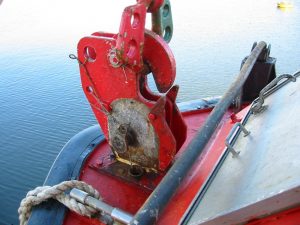 |
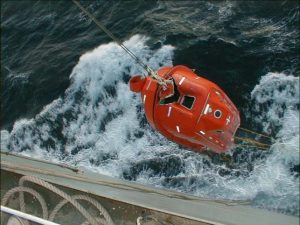 |
LAUNCHING APPLIANCES
- Ensure limit switches are operating correctly.
- Inspection of davit structure and fastenings to the deck.
- Lubrication of sheaves, wires and moving parts.
- Control units in good condition free to move.
- Mechanical systems in good condition.
- Arrangements free from excessive paint and rust.
- Brake pads inspected and in good condition.
- Power supply and back up stored power for launching.
- Visual inspection of fall wire for damage, corrosion and lack of lubrication.
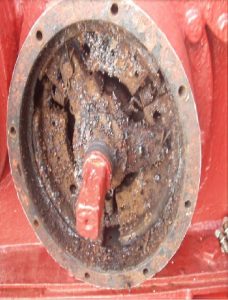 |
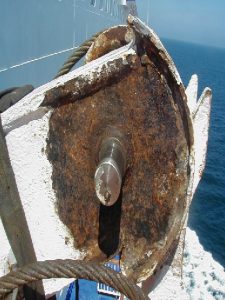 |
LIFE RAFTS
Stowage and inspection:
- Ensure painter line is correctly rigged to the weak link on the hydrostatic release unit. At no time should the painter line be connected directly to strong point on the ship.
- Ensure raft is secure in its frame. The bellyband should be tight enough to restrict movement at sea and should be made of material easy to cut.
- Ensure quick release slip is in good working condition and not seized.
- Ensure embarkation ladders are in good condition and accessible.
- Ensure the rafts casing is showing no signs of damage..
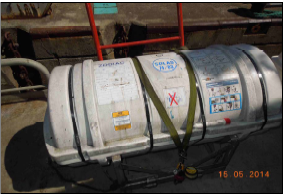 |
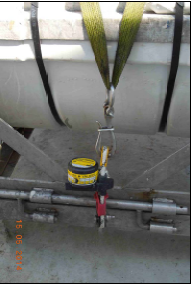 |
Launching arrangements for davit launched rafts:
- Ensure controls, winch and slewing arm are accessible and in good working order.
- Ensure any cleats for additional painter (and if applicable container) lines are in good condition.
- Thorough inspection of the life raft release hook to ensure it is good condition, free to move and functioning correctly.
- Inspection of the davit foundations and connections to the deck.
- Inspection of winch wire, sheaves and slewing gear to ensure adequate lubrication, free from corrosion and excessive paint.

 English
English